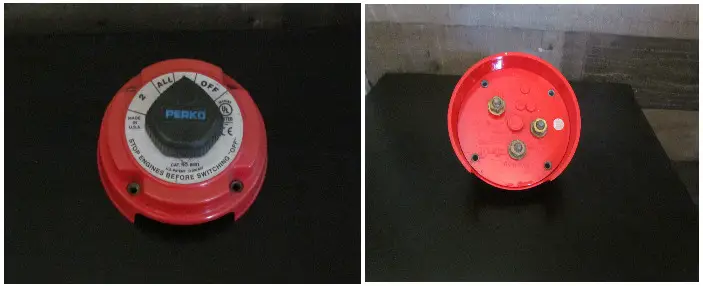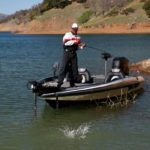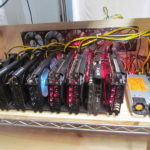Managing the batteries on your boat can be challenging to say the least. But if you start with a 2 battery bank switch, you will be on the correct path.
In this article, we will tell you what you need to know about 2 battery bank switches.
Note: most links in this article are Amazon.com Affiliate links, see Affiliate Disclosure, thank you.
What Are 2 Bank Battery Switches?
Battery switches are used to connect or disconnect batteries from loads. This can be a benefit when you are storing your boat or not using it for long periods. Another benefit of a two bank battery switch is to simultaneously switches between two battery banks while isolating the two separate battery banks from one another. This allows you to have two separate battery banks, one with a starter battery connected to your boat engine and the other a deep cycle marine battery to power all your boat’s energy needs.
These energy needs might include a refrigerator, stereo, lights, depth finder, USB charging ports, and anything else you need, including a cigarette lighter plug. If your boat has more than one engine, or you have a large boat that requires a lot of electrical power, you can add additional battery banks and additional battery bank switches to manage all your battery banks.
A dual bank battery switch is another name for the two bank battery switch. So, if you hear it referred to as “dual” don’t worry, it is the same type switch.
Why Are 2 Bank Battery Switches Important?
Two bank battery switches are important because:
- Battery isolation is key: By isolating multiple battery banks from one another, you will protect all your boat’s electronics, and you will make sure you always have enough power to start your engine. When you start your engine, voltage spikes and sags can occur that can damage other small electronics on your boat.
- Extra battery power: Having multiple battery banks hooked up to a two-battery bank switch is great for isolating each battery bank from one another. However, sometimes you can combine them for increased power. For example, you have been out fishing all day and not running the main engine, and you had forgotten to recharge the battery banks the day before. You may have some low battery power in the starter battery bank. Go ahead and flip the switch to the combined or 1+2 setting and try starting the engine again. You will then pull power from both battery banks to get your engine started. Once your engine is started, turn the switch to the starter battery bank to ensure your engine’s alternator is recharging the starter battery bank.
- Save battery power: Having a two-battery bank switch also will allow you to prevent the battery from draining during times of inactivity by flipping the switch to the off position. If there is an emergency, you can also easily shut down the entire electrical system by flipping the switch to off. You could even install a key locking device that will keep the switch in the off position, which would not allow any unauthorized user to start the engine or use any of the boat’s electrical systems.
- Separate different battery types: If you have different chemistry-type batteries on your boat for equipment like a trolling motor, fish finder, or stereo, you might use a lithium-based battery. Lithium batteries are not 100% compatible with lead acid batteries, so selecting a 2 bank battery switch might be a perfect option.
Having a two battery bank switch is simply convenient for having multiple battery banks on your vessel. Aside from the protection that a two-battery bank switch offers, it can produce backup power by combining multiple battery banks to start an engine.
In practice, for a 24 volt trolling motor, you can set up your system with four batteries divided into 2 banks. Connecting a 4 bank onboard battery charger(4 battery charger) to all four batteries in your system can maintain your batteries excellently. Then, the 2 bank battery switch will manage which battery bank you are drawing your trolling motor power from.
How to Install 2 Bank Battery Switches
Suppose you are looking at how to wire a boat battery switch. In that case, you can look for instructions online, follow the switch manufacturer’s instructions or contact them for additional resources, or you could find an instructional video on YouTube.
Here is a basic step-by-step guide to giving you an idea of what you may be in for. If you need further and more detailed instructions, we recommend checking out the YouTube clip above.
There are several different setups that you could choose from based on what kind of features your boat has. When there is a single engine with a single battery setup, a switch is still good for being able to cut power when needing to conserve your battery during storage.
The single-engine with two batteries setup allows you to isolate your engine battery from the battery used for your boat’s onboard electronics. Then there are more advanced setups for multiple engines, multiple battery banks, and multiple switches. For the sake of simplicity, we are going to only look at the one engine with two battery banks set up.
- Install the switch in a central location that can be reached with wires from the house electronics panel, the engine, and the automatic charging relay. Also, choose a place that will be free from excessive water exposure.
- Go ahead and wire the engine and the house electronics panel to the switch. There should be one designated terminal for both the positive wires from the engine and the electronics panel.
- Take the positive red wire from your starter battery bank and connect it to one of the terminals on the switch. Remember which one you choose if it is numbered.
- Take the positive red wire from your deep cycle marine battery bank and connect it to the other terminal on the switch.
- Run positive wires from the positive terminals of both the starter battery and the deep cycle marine battery banks to the automatic charging relay.
- Complete the proper ground wiring from the house electronics panel, the engine, and each of the battery banks. We recommend using a heavy-duty terminal for this connection.
Again, this is a simple explanation of how to wire a two-battery bank switch for a single-engine and two battery bank setup. If you need further details, go ahead, and watch an instructional video on YouTube or contact a marine electronics professional. Contacting a marine electronics professional is the best course of action if you are uncomfortable with any aspect of the installation and wiring process.
Safety Notes for 2 Bank Battery Switches
Always turn off your engine or electronic devices before switching your 2 bank battery switch unless the manufacturer recommends otherwise. Power surges from connecting two batteries at different states of charge can damage your batteries, electronics, or even your engine’s charging system.
Additionally, never use a 2 bank battery switch to connect batteries or battery banks of different voltages. Combining a 24-volt battery bank with a 12-volt battery bank could be very dangerous.
Tips for Buying 2 Bank Battery Switches
When you are considering installing a second battery bank and a two bank battery switch system, there are a few considerations you should be aware of before making any purchases.
First, you will need to consider the battery types. Charging characteristics can vary between battery types, and therefore, electronic integration between multiple battery banks and all other components is easier if all batteries are the same type.
Second, know what class of battery you will need for your kind of boating activities. Some people can get by with a simple setup using two battery banks filled with dual-purpose batteries. Other people, for example, fishermen with trolling motor setups, depth finders, GPS, stereos, lighting, etc., may need to consider having a starting battery bank for their engine and a deep cycle marine battery bank for all other electronics.
Third, you will want to make sure the battery capacity of your battery banks carries a sufficient amperage rating to meet your expected amperage draw for the assumed period of time that you will need.
Fourth, manual versus automatic switches: A manual switch is easy to use and install, but then you will need to always keep track of each battery bank and its power levels. You can run your boat’s engine and use the alternator to recharge whichever battery bank you need to. An automatic switch uses voltage-sensitive relays to sense which battery bank needs recharging from the engine’s alternator.
Fifth, you will want to make sure the battery banks and all electronic components are easily accessible. Keep all battery banks and electronic components close to one another, easy to get at, and away from a boat’s fuel system.
Last, the cables or wires that you purchase will need to be the correct diameter to carry the proper amperage over the distance it needs to go from one component to the battery bank. For example, the cable from your boat’s house electronics panel to your deep cycle marine battery bank needs to be thick enough to ensure no voltage drop occurs when electricity is transferred between the two.
Our Top Picks for 2 Bank Battery Switches
For starting battery and accessory battery of the same chemistry –
Perko 8501DP Medium Duty Battery Selector Switch Red, Small


For trolling motors with the same or different chemistry battery banks –
Blue Sea Systems 300 Amp m-Series Battery Switches

Testing Notes:
We tested all of these switches at 12, 24, and 36 volts, even if the switch wasn’t rated for 36 volts. Our primary test was to run a 24-volt trolling motor at 50 amps for one hour. Our second test was to start the main engine (Mercury 115 Optimax Pro) on a 12-volt battery, 1000 watt inverter, and a 12-volt spotlight.
For more information on 2 bank battery switches check out our article
“Using a Dual Bank Battery Switch for Your Electric Trolling Motor“
Conclusion
Battery switches can protect your battery when not in use, and 2 bank battery switches can help you manage your battery banks. We have explained how and why 2 bank battery switches work in this article.
Our top pick for a starting and accessory battery of the same chemistry is the Perko 8501DP Medium Duty Battery Selector Switch. The overall performance and time-tested reliability make this an easy choice.




[…] Check out our article that explains battery switches used in a starting battery application in more detail. […]